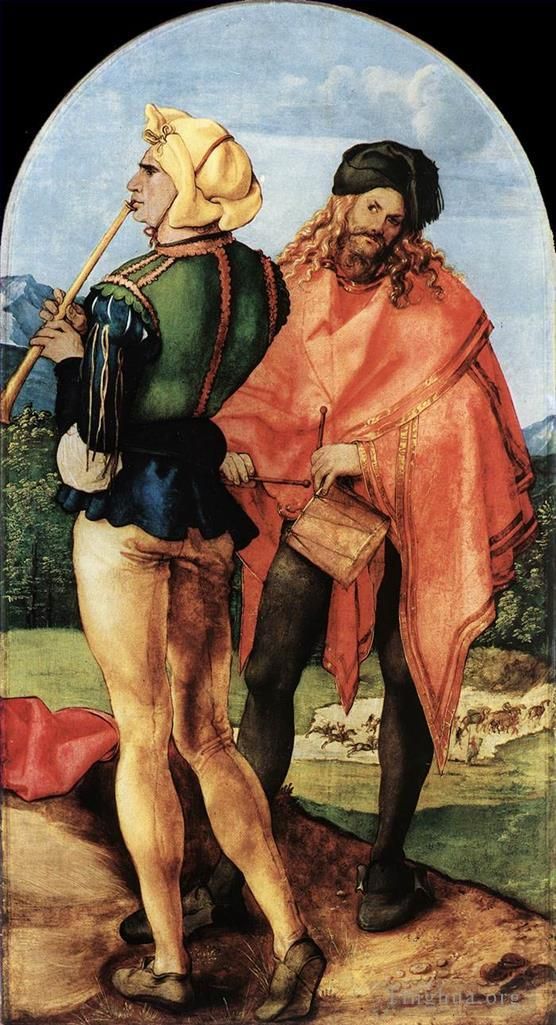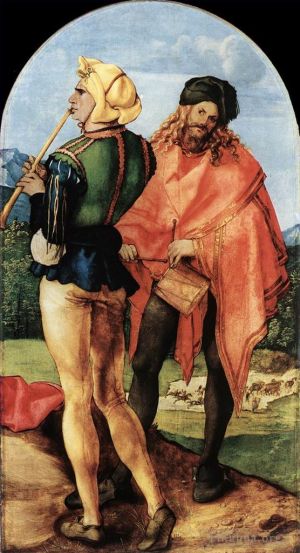Two Musicians
Albrecht Durer
- Price: Price on Request
- Art Type: Oil Painting
- Size:
- English Comments: 0
- International Comments: 0
- Creating Date:
- Introduction and Works of Albrecht Durer >>
Keywords:
Musicians
Work Overview
- Two Musicians
Albrecht Dürer
c. 1504
Oil on panel
94 x 51 cm
Wallraf-Richartz-Museum, Cologne
The panel is a wing of the Jabach Altarpiece, named after one of its previous owners. Originally, however, it was commissioned by Frederick the Wise, elector of Saxony. Another panel in Frankfurt, depicting Job and his wife, belongs to this altar, too. It is conceivable that these two pictures are the results of sawing a larger one in two. Even though their conditions differ, it is clearly visible that the background and the horizon in both pictures match, and portions of the clothes of Job's wife may be found in the picture of the two musicians. There is even a sixteenth-century drawing which shows the two paintings as one composition. The two pictures together may have constituted the centre panel of a Job altar commissioned by Frederick the Wise to commemorate the plague which ravaged the German lands in 1503.
It should be noted that there are scholars who have proposed that these two pictures used to form the two wing-panels of a triptych showing the Adoration of the Magi (now in the Galleria degli Uffizi in Florence).
The altar, besides depicting Job as the patron saint of people suffering skin diseases, also points to his connection with music. On the first part of the painting we see the suffering Job cowering on a refuse heap while his wife drenches him with water. On the second part, the musicians are certainly the representatives of healing music. (The young drummer bears striking resemblance to the painter). According to the medieval melotherapy, Job, who was devoted to music when he was healthy, should recover upon hearing the melody.
The presence of a wind instrument, a type of trumpet, may suggest another association. In praise of the instruments, St Augustine likened the brazen tone of the trumpet to the steadfastness of Job.
For whom were they playing, the musicians Albrecht Dürer portrays here? This panel is the outside of the right-hand wing of a triptych and has a pair currently in the Städel Museum in Frankfurt, on which is depicted the figure of Job, weighed down by sickness and suffering. His faith is being sorely tested by the assaults of the Devil. Thus his herd has been stolen, for example (you can see the rustlers at work in the background of the Cologne panel).
The wing in the Städel Museum shows Job’s wife pouring water over her melancholic husband. The art historian Bodo Brinkmann suggested some time ago that this gesture was not one of scorn, as it had usually been seen, but rather a therapeutic measure. The triptych was probably once set up in the chapel of an early spa, known as the Hiobsbad (Job’s Bath), near Annaberg in Saxony.
The two musicians are also trying to comfort the sick Job. They are seeking to console him with their cheerful music, the rousing sound of the pipe and the stirring rhythm of the drum. Interestingly, the facial features of the drummer are Dürer’s own. Did he see himself in a similar role as painter?
- Copyright Statement:
All the reproduction of any forms about this work unauthorized by Singing Palette including images, texts and so on will be deemed to be violating the Copyright Laws.
To cite this webpage, please link back here.
- >> English Comments
- >> Chinese Comments
- >> French Comments
- >> German Comments
- >>Report
- Emperor Charlemagne
- Virgin Suckling the Child
- Emperor Charlemagne and Emperor Sigismund
- The Apostles Philip and James
- The Cross
- Salvator Mundi
- The Dresden Altarpiece
- St Peter
- Portrait of Emperor Maximilian I
- Alliance Coat of Arms of the Durer and Holper Families
- Portrait of Jacob muffle
- Saint Jerome (St Jerome in the Wilderness)
- Paumgartner Altar right wing
- Portrait of St Sebastian with an Arrow
- Portrait of a Boy with a Long Beard
- Adam and Eve
- The Jabach Altarpiece
- Suicide of Lucretia
- The Seven Sorrows of the Virgin
- Portrait of Oswolt Krel full
- Self-Portrait (Portrait of the Artist Holding a Thistle)
- Four Apostles
- Portrait of a Young Man
- Lots escape
- Portrait of a Man 1504
- Portrait of Hieronymus Holzschuher
- St Jerome
- Twelve year old Jesus in the Temple
- Circumcision of Jesus (Seven Sorrows The Circumcision)
- John
- Christ as the Man of Sorrows
- Holy Family
- The Dresden Altarpiece central panel
- Christ among the Doctors
- Sylvan Men with Heraldic Shields Albrecht Durer
- Job and His Wife
- Maria with child
- The Four Apostles left part St John and St Peter
- The Seven Sorrows of the Virgin The Flight into Egypt
- Portrait of Elector Frederick the Wise of Saxony
- Paumgartner Altar left wing
- Portrait of Elsbeth Tucher
- The Virgin Mary in Prayer
- Ecce Homo
- Portrait of Barbara Durer
- The Madonna of the Carnation
- Portrait of a Young Furleger with Her Hair Done Up
- Combined Coat of Arms of the Tucher and Rieter Families
- Paumgartner altarpiece
- Portrait of a Young Furleger with Loose Hair
- Adoration of the Trinity (Landauer Altarpiece)
- Portrait of Durers Father at 70
- Portrait of a Man 2
- Two Musicians
- The Seven Sorrows of the Virgin Mother of Sorrows
- Portrait of a Young Venetian Woman
- Felicitas Tucher nee Rieter
- Albrecht Portrait of a Man
- Self-Portrait (Self-Portrait with Fur-Trimmed Robe)
- Virgin and Child before an Archway
- Madonna and Child Haller Madonna
- Virgin and child holding a half eaten pear
- The Dresden Altarpiece side wings
- Lot and His Daughters (Lot Fleeing with his Daughters from Sodom)
- Madonna with the Siskin
- Drummers and pipers
- Self-Portrait at 26
- Face a young girl with red beret
- Hans Tucher
- The flight to Egypt Softwood
- Lamentation of Christ
- Hercules kills the Symphalic Bird
- Portrait of the Elder
- Seven Sorrows Crucifixion
- Eve Renaissance
- Avarice
- Virgin and Child with Saint Anne
- Adoration of the Magi
- Martyrdom of the Ten Thousand
- The Lady of the festival du Rosaire
- Emperor Sigismund
- Sylvan Men with Heraldic Shields
- Portrait of Oswolt Krel
- Lamentation for Christ
- The Wire-Drawing Mill
- Primula
- The tuft of grass MINOR
- Garza
- The Little Owl
- Crucifixion
- Cervus Lucanus
- View of Nuremberg
- Lobster
- The Holy Family in a Trellis
- Nuremberg Woman Dressed for Church
- The Castle at Trento
- Innsbruck
- House by a Pond
- Head of an Angel
- Courtyard of the Former Castle in Innsbruck with Clouds
- Lion
- Iris
- Hands
- Hand
- Cupid the Honey Thief
- Self portrait at 13
- View of the Arco Valley in the Tyrol
- Head of a Stag
- The Trefileria on Peignitz
- Arion 2
- Arion
- Knight On Horseback
- A Young Hare
- The Trefileria on Peignitz 2
- Pond in the wood
- Dry dock at Hallerturlein Nuremberg
- Willow Mill
- The Prodigal Son
- View of Kalchreut
- Saint John Church
- Iris Troiana
- The Fall
- Doss Trento
- Innsbruck Seen from the North
- Hare
- Tilo on the cantilever of a bastion
- Courtyard of the Former Castle in Innsbruck without Clouds
- Dead Bluebird
- Map of the Southern Sky
- The city of Trento
- Three Mighty Ladies from Livonia









 Singing Palette
Singing Palette